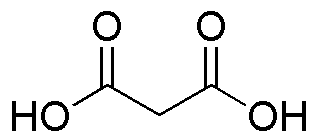Malonic acid anhydrous is widely utilized in research focused on:
- Synthesis of Pharmaceuticals: It serves as a key building block in the synthesis of various pharmaceutical compounds, enhancing the efficiency of drug development.
- Biochemical Research: This compound is used in metabolic studies and enzyme research, helping scientists understand biochemical pathways and enzyme functions.
- Polymer Production: Malonic acid anhydrous is employed in the production of biodegradable polymers, contributing to environmentally friendly materials in the plastics industry.
- Food Industry: It acts as a food additive, particularly in flavor enhancement and preservation, ensuring food safety and quality.
- Cosmetic Formulations: The compound is used in cosmetics for its moisturizing properties, providing benefits in skin care products.
Informations générales
Propriétés
Sécurité et réglementation
Applications
Malonic acid anhydrous is widely utilized in research focused on:
- Synthesis of Pharmaceuticals: It serves as a key building block in the synthesis of various pharmaceutical compounds, enhancing the efficiency of drug development.
- Biochemical Research: This compound is used in metabolic studies and enzyme research, helping scientists understand biochemical pathways and enzyme functions.
- Polymer Production: Malonic acid anhydrous is employed in the production of biodegradable polymers, contributing to environmentally friendly materials in the plastics industry.
- Food Industry: It acts as a food additive, particularly in flavor enhancement and preservation, ensuring food safety and quality.
- Cosmetic Formulations: The compound is used in cosmetics for its moisturizing properties, providing benefits in skin care products.
Documents
Fiches de données de sécurité (FDS)
La FDS fournit des informations de sécurité complètes sur la manipulation, le stockage et l’élimination du produit.
Spécifications du produit (PS)
Le PS fournit une description complète des propriétés du produit, notamment sa composition chimique, son état physique, sa pureté et les exigences de stockage. Il détaille également les plages de qualité acceptables et les applications prévues du produit.
Certificats d'analyse (COA)
Recherchez des certificats d'analyse (COA) en saisissant le numéro de lot du produit. Les numéros de lot et de lot se trouvent sur l'étiquette d'un produit, après les mots « Lot » ou « Lot de fabrication ».
Numéro de catalogue
Numéro de lot/série
Certificats d'origine (COO)
Ce certificat d'exploitation confirme le pays dans lequel le produit a été fabriqué, et détaille également les matériaux et composants utilisés et s'il est issu de sources naturelles, synthétiques ou autres sources spécifiques. Ce certificat peut être requis pour les douanes, le commerce et la conformité réglementaire.
Numéro de catalogue
Numéro de lot/série
Fiches de données de sécurité (FDS)
La FDS fournit des informations de sécurité complètes sur la manipulation, le stockage et l’élimination du produit.
DownloadSpécifications du produit (PS)
Le PS fournit une description complète des propriétés du produit, notamment sa composition chimique, son état physique, sa pureté et les exigences de stockage. Il détaille également les plages de qualité acceptables et les applications prévues du produit.
DownloadCertificats d'analyse (COA)
Recherchez des certificats d'analyse (COA) en saisissant le numéro de lot du produit. Les numéros de lot et de lot se trouvent sur l'étiquette d'un produit, après les mots « Lot » ou « Lot de fabrication ».
Numéro de catalogue
Numéro de lot/série
Certificats d'origine (COO)
Ce certificat d'exploitation confirme le pays dans lequel le produit a été fabriqué, et détaille également les matériaux et composants utilisés et s'il est issu de sources naturelles, synthétiques ou autres sources spécifiques. Ce certificat peut être requis pour les douanes, le commerce et la conformité réglementaire.

